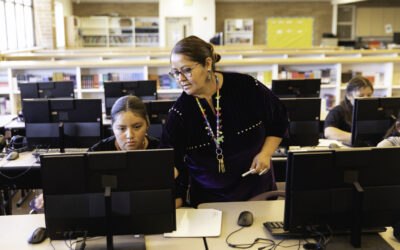By integrating computational thinking skills early in educational curricula, students develop a set of tools to tackle problems more effectively and efficiently. These skills prepare them for a wide range of careers that require systematic thinking and problem-solving. Computational thinking also encourages students to analyze and synthesize information, promotes critical thinking, creativity, and helps develop the ability to work collaboratively in complex environments. These are essential skills for success in the 21st-century workforce.
Explore the definition of computational thinking here.
Activities to Practice Computational Thinking for Elementary, Middle School, and High School Students
It’s important for educators to introduce computational thinking activities at various educational stages to help strengthen this skill in students of all ages. This article provides activities tailored for elementary, middle school, and high school students, designed to enhance their computational thinking skills in engaging and age-appropriate ways.
Computational Thinking Activities for Elementary Students
Step-by-Step Cards
In this activity, students learn about algorithms by creating simple step-by-step instructions to complete everyday tasks.
Activity: Break the class into small groups and assign each group a common task like making a sandwich, organizing books or setting a table. Each group writes down instructions on index cards. They then exchange their cards with another group to execute the instructions literally as written. This highlights the importance of clarity and sequence in algorithms.
Skills Developed: Sequence recognition, logical flow and problem decomposition.
2. Pattern Recognition with Blocks
This activity helps enhance pattern recognition and prediction skills, which are critical components of computational thinking.
Activity: Using colored blocks or similar objects, teachers create sequences based on simple rules. Students must predict the next few items in the sequence. Gradually, the patterns can become more complex as the students’ skills develop.
Skills Developed: Pattern recognition, abstraction and prediction.
3. Debugging Story Time
In this activity, educators can help introduce the concept of debugging by finding and fixing errors in simple stories or pictures.
Activity: Present a story or a picture sequence with deliberate mistakes (e.g., narrative inconsistencies or misplaced elements in a picture sequence). Students must identify and correct the mistakes.
Skills Developed: Problem-solving, attention to detail, and critical thinking.
Computational Thinking Activities for Jr. High School Students
1. Flowchart Fun
Teach students how to visualize processes and decisions through flowchart creation.
Activity: Students select a process (e.g., deciding what to eat for lunch or how to spend a weekend) and create a flowchart that includes possible decisions and outcomes. This can be done using paper and markers or digital tools like Lucidchart.
Skills Developed: Decision-making, logical reasoning and process visualization.
2. Block-Based Coding
Introduce basic programming concepts using a block-based coding language.
Activity: Using Scratch or Learning.com’s EasyCode learning platform students create simple animations or games. Teachers can guide them through the process of using loops, conditional statements, and variables.
Skills Developed: Programming logic, creativity and computational thinking fundamentals.
3. Robotics Challenges
In this activity, students use computational thinking in a tangible way through robotics.
Activity: Using kits like LEGO Mindstorms, students work in teams to build and program robots to complete specific tasks, such as navigating a maze or moving objects from one place to another.
Skills Developed: Teamwork, problem-solving and applying computational principles in real-world scenarios.
Computational Thinking Activities for High School Students
Data Analysis Projects
This activity helps students develop the ability to analyze and interpret data, a key aspect of computational thinking.
Activity: Students collect data or use existing datasets to find trends, make predictions, or solve problems. They can use tools like Excel, Python, or R for data analysis and visualization.
Skills Developed: Data literacy, statistical analysis and hypothesis testing.
2. Algorithm Design
Engage students in creating algorithms for more complex problems.
Activity: Assign projects where students need to develop algorithms to solve problems like sorting a list, finding the shortest path between points, or creating a simple encryption system.
Skills Developed: Algorithmic thinking, efficiency analysis and complex problem-solving.
3. Hackathons
Hackathon activities help foster a collaborative environment to solve problems using computational thinking under time constraints.
Activity: Organize a hackathon where students form teams to develop software solutions for given problems within a limited time. This encourages innovation, teamwork and the application of computational thinking across different scenarios.
Skills Developed: Collaboration, innovation and endurance in problem-solving.
Final Thoughts
By integrating computational thinking activities into the curriculum at various educational levels, educators can provide students with the skills necessary to tackle complex problems, think critically and approach challenges with a systematic perspective. These activities not only prepare students for academic success but also for future careers in a diverse range of fields.
For more information about Learning.com’s EasyCode program and its hands-on computational thinking activities, click the button below.

Learning.com Team
Staff Writers
Founded in 1999, Learning.com provides educators with solutions to prepare their students with critical digital skills. Our web-based curriculum for grades K-12 engages students as they learn keyboarding, online safety, applied productivity tools, computational thinking, coding and more.
Further Reading
How Were the TEKS Created & What is Its Significance?
The Texas Essential Knowledge and Skills (TEKS) framework details the educational standards in the state of Texas, providing a comprehensive outline...
CIPA Compliance Made Easy with Learning.com
The Children’s Internet Protection Act (CIPA), enacted by Congress in 2000, addresses concerns about children’s access to harmful online content. It...
Students as Logical Thinkers: How Computer Science Teaches Real-World Skills
There is little debate that computer science education has become an imperative curriculum for future-ready students. From modern professions and...




